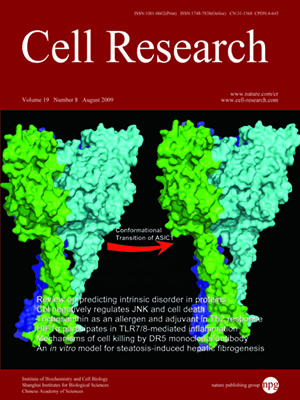
Volume 19, No 8, Aug 2009
ISSN: 1001-0602
EISSN: 1748-7838 2018
impact factor 17.848*
(Clarivate Analytics, 2019)
Volume 19 Issue 8, August 2009: 929-949
REVIEWS
Predicting intrinsic disorder in proteins: an overview
Bo He1, Kejun Wang1, Yunlong Liu2,5,6, Bin Xue2,3,4, Vladimir N Uversky2,3,4,7 and A Keith Dunker2,3,4
1College of Automation, Harbin Engineering University, Harbin, Heilongjiang 150001, China
2Center for Computational Biology and Bioinformatics, Indiana University School of Medicine, Indianapolis, IN 46202, USA
3Department of Biochemistry and Molecular Biology, Indiana University School of Medicine, Indianapolis, IN 46202, USA
4Institute for Intrinsically Disordered Protein Research, Indiana University School of Medicine, Indianapolis, IN 46202, USA
5Division of Biostatistics, Department of Medicine, Indiana University School of Medicine, Indianapolis, IN 46202, USA
6Center for Medical Genomics, Indiana University School of Medicine, Indianapolis, IN 46202, USA
7Institute for Biological Instrumentation, Russian Academy of Sciences, 142290 Pushchino, Moscow Region, Russia
Correspondence: Kejun Wang, A Keith Dunker,(wangkejun@hrbeu.edu.cn; kedunker@iupui.edu)
The discovery of intrinsically disordered proteins (IDP) (i.e., biologically active proteins that do not possess stable secondary and/or tertiary structures) came as an unexpected surprise, as the existence of such proteins is in contradiction to the traditional "sequence→structure→function" paradigm. Accurate prediction of a protein's predisposition to be intrinsically disordered is a necessary prerequisite for the further understanding of principles and mechanisms of protein folding and function, and is a key for the elaboration of a new structural and functional hierarchy of proteins. Therefore, prediction of IDPs has attracted the attention of many researchers, and a number of prediction tools have been developed. Predictions of disorder, in turn, are playing major roles in directing laboratory experiments that are leading to the discovery of ever more disordered proteins, and thereby leading to a positive feedback loop in the investigation of these proteins. In this review of algorithms for intrinsic disorder prediction, the basic concepts of various prediction methods for IDPs are summarized, the strengths and shortcomings of many of the methods are analyzed, and the difficulties and directions of future development of IDP prediction techniques are discussed.
Cell Research (2009) 19:929-949. doi: 10.1038/cr.2009.87; published online 14 July 2009
FULL TEXT | PDF
Browse 1820


